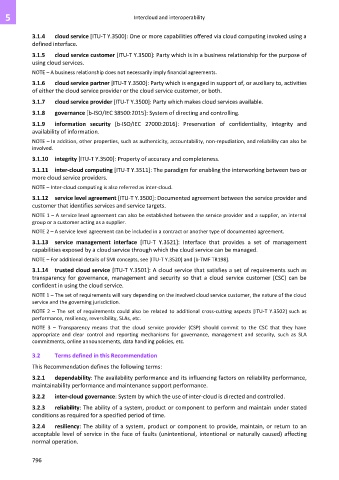Page 804 - Cloud computing: From paradigm to operation
P. 804
5 Intercloud and interoperability
3.1.4 cloud service [ITU-T Y.3500]: One or more capabilities offered via cloud computing invoked using a
defined interface.
3.1.5 cloud service customer [ITU-T Y.3500]: Party which is in a business relationship for the purpose of
using cloud services.
NOTE – A business relationship does not necessarily imply financial agreements.
3.1.6 cloud service partner [ITU-T Y.3500]: Party which is engaged in support of, or auxiliary to, activities
of either the cloud service provider or the cloud service customer, or both.
3.1.7 cloud service provider [ITU-T Y.3500]: Party which makes cloud services available.
3.1.8 governance [b-ISO/IEC 38500:2015]: System of directing and controlling.
3.1.9 information security [b-ISO/IEC 27000:2016]: Preservation of confidentiality, integrity and
availability of information.
NOTE – In addition, other properties, such as authenticity, accountability, non-repudiation, and reliability can also be
involved.
3.1.10 integrity [ITU-T Y.3500]: Property of accuracy and completeness.
3.1.11 inter-cloud computing [ITU-T Y.3511]: The paradigm for enabling the interworking between two or
more cloud service providers.
NOTE – Inter-cloud computing is also referred as inter-cloud.
3.1.12 service level agreement [ITU-T Y.3500]: Documented agreement between the service provider and
customer that identifies services and service targets.
NOTE 1 – A service level agreement can also be established between the service provider and a supplier, an internal
group or a customer acting as a supplier.
NOTE 2 – A service level agreement can be included in a contract or another type of documented agreement.
3.1.13 service management interface [ITU-T Y.3521]: Interface that provides a set of management
capabilities exposed by a cloud service through which the cloud service can be managed.
NOTE – For additional details of SMI concepts, see [ITU-T Y.3520] and [b-TMF TR198].
3.1.14 trusted cloud service [ITU-T Y.3501]: A cloud service that satisfies a set of requirements such as
transparency for governance, management and security so that a cloud service customer (CSC) can be
confident in using the cloud service.
NOTE 1 – The set of requirements will vary depending on the involved cloud service customer, the nature of the cloud
service and the governing jurisdiction.
NOTE 2 – The set of requirements could also be related to additional cross-cutting aspects [ITU-T Y.3502] such as
performance, resiliency, reversibility, SLAs, etc.
NOTE 3 – Transparency means that the cloud service provider (CSP) should commit to the CSC that they have
appropriate and clear control and reporting mechanisms for governance, management and security, such as SLA
commitments, online announcements, data handling policies, etc.
3.2 Terms defined in this Recommendation
This Recommendation defines the following terms:
3.2.1 dependability: The availability performance and its influencing factors on reliability performance,
maintainability performance and maintenance support performance.
3.2.2 inter-cloud governance: System by which the use of inter-cloud is directed and controlled.
3.2.3 reliability: The ability of a system, product or component to perform and maintain under stated
conditions as required for a specified period of time.
3.2.4 resiliency: The ability of a system, product or component to provide, maintain, or return to an
acceptable level of service in the face of faults (unintentional, intentional or naturally caused) affecting
normal operation.
796

